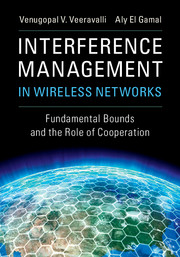Book contents
- Frontmatter
- Contents
- Preface
- Acknowledgments
- 1 Introduction to Interference Management
- 2 System Model and Sum Capacity Characterization
- 3 Degrees of Freedom and Interference Alignment
- 4 Iterative Algorithms for Interference Management
- 5 Degrees of Freedom with Coordinated Multi-Point Transmission
- 6 Locally Connected Channels with CoMP
- 7 Backhaul Load Constraint
- 8 Cellular Uplink
- 9 Dynamic Interference Management
- 10 Recent Advances and Open Problems
- Appendix A Information Theory
- Appendix B Algebraic Geometry
- References
- Index
9 - Dynamic Interference Management
Published online by Cambridge University Press: 09 February 2018
- Frontmatter
- Contents
- Preface
- Acknowledgments
- 1 Introduction to Interference Management
- 2 System Model and Sum Capacity Characterization
- 3 Degrees of Freedom and Interference Alignment
- 4 Iterative Algorithms for Interference Management
- 5 Degrees of Freedom with Coordinated Multi-Point Transmission
- 6 Locally Connected Channels with CoMP
- 7 Backhaul Load Constraint
- 8 Cellular Uplink
- 9 Dynamic Interference Management
- 10 Recent Advances and Open Problems
- Appendix A Information Theory
- Appendix B Algebraic Geometry
- References
- Index
Summary
An important requirement of next-generation (5G) wireless systems is the ability to autonomously adjust to varying environmental conditions. Our focus in this chapter is to analyze information-theoretic models of interference networks that capture the effect of deep fading conditions through introducing random link erasure events in blocks of communication time slots.More specifically, in order to consider the effect of long-term fluctuations (deep fading or shadowing), we assume that communication takes place over blocks of time slots, and independent link erasures occur with probability p in each block.
We can observe through the results presented in Chapters 5–8 that conclusions related to the optimal associations of mobile terminals to basestations and the achievable DoF differ dramatically based on the network topology. For example, under the maximum transmit set size constraint for the downlink, local cooperation cannot lead to a gain in the achieved asymptotic per-user DoF for the fully connected channel. However, local cooperation is optimal for locally connected channels and can lead to achieving scalable DoF gains, and the optimal assignment of messages to transmitters depends on the connectivity parameter L. In practice, the topology may change due to deep fading conditions (see, e.g., [6]) or even intentionally to exploit spectrum opportunities (see, e.g., [94]). In this chapter, we extend our DoF results to dynamic interference networks where a fixed assignment of messages is selected to achieve average DoF optimal performance in networks with changing topology.
In [95], the authors analyzed the average capacity for a point-to-point channel model where slow changes result in varying severity of noise. We apply a similar concept to interference networks by assuming that slowly changing deep fading conditions result in link erasures.We consider the linear interference network (L=1) that was introduced in Chapter 6, and look at two fading effects: long-term fluctuations that result in link erasures over a complete block of time slots, and short-term fluctuations that allow us to assume that any specific joint realization for the non-zero channel coefficients will take place with zero probability. We study the problem of achieving the optimal average degrees of freedom under a maximum transmit set size constraint (5.16). We note that the problem studied in Chapter 6 reduces to the case of no erasures.
Information
- Type
- Chapter
- Information
- Interference Management in Wireless NetworksFundamental Bounds and the Role of Cooperation, pp. 165 - 182Publisher: Cambridge University PressPrint publication year: 2018
